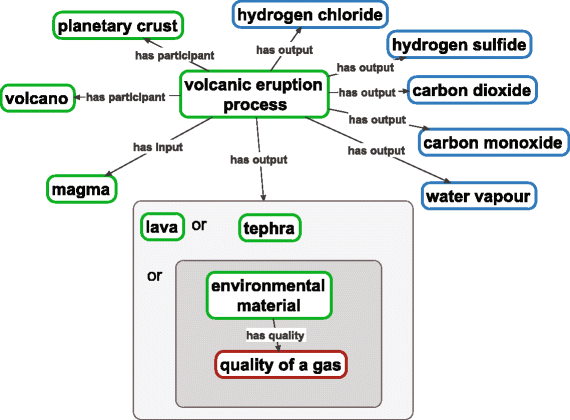The environment ontology in 2016: bridging domains with increased scope, semantic density, and interoperation
- PMID: 27664130
- PMCID: PMC5035502
- DOI: 10.1186/s13326-016-0097-6
The environment ontology in 2016: bridging domains with increased scope, semantic density, and interoperation
Abstract
Background: The Environment Ontology (ENVO; http://www.environmentontology.org/ ), first described in 2013, is a resource and research target for the semantically controlled description of environmental entities. The ontology's initial aim was the representation of the biomes, environmental features, and environmental materials pertinent to genomic and microbiome-related investigations. However, the need for environmental semantics is common to a multitude of fields, and ENVO's use has steadily grown since its initial description. We have thus expanded, enhanced, and generalised the ontology to support its increasingly diverse applications.
Methods: We have updated our development suite to promote expressivity, consistency, and speed: we now develop ENVO in the Web Ontology Language (OWL) and employ templating methods to accelerate class creation. We have also taken steps to better align ENVO with the Open Biological and Biomedical Ontologies (OBO) Foundry principles and interoperate with existing OBO ontologies. Further, we applied text-mining approaches to extract habitat information from the Encyclopedia of Life and automatically create experimental habitat classes within ENVO.
Results: Relative to its state in 2013, ENVO's content, scope, and implementation have been enhanced and much of its existing content revised for improved semantic representation. ENVO now offers representations of habitats, environmental processes, anthropogenic environments, and entities relevant to environmental health initiatives and the global Sustainable Development Agenda for 2030. Several branches of ENVO have been used to incubate and seed new ontologies in previously unrepresented domains such as food and agronomy. The current release version of the ontology, in OWL format, is available at http://purl.obolibrary.org/obo/envo.owl .
Conclusions: ENVO has been shaped into an ontology which bridges multiple domains including biomedicine, natural and anthropogenic ecology, 'omics, and socioeconomic development. Through continued interactions with our users and partners, particularly those performing data archiving and sythesis, we anticipate that ENVO's growth will accelerate in 2017. As always, we invite further contributions and collaboration to advance the semantic representation of the environment, ranging from geographic features and environmental materials, across habitats and ecosystems, to everyday objects in household settings.
Keywords: Anthropogenic environment; Ecosystem; Environmental semantics; Habitat; Indoor environment; Ontology; Sustainable development.
Figures



References
-
- Field D, Amaral-Zettler L, Cochrane G, Cole JR, Dawyndt P, Garrity GM, Gilbert J, Glöckner FO, Hirschman L, Karsch-Mizrachi I, Klenk H-P, Knight R, Kottmann R, Kyrpides N, Meyer F, San Gil I, Sansone S-A, Schriml LM, Sterk P, Tatusova T, Ussery DW, White O, Wooley J. The Genomic Standards Consortium. PLoS Biol. 2011;9:e1001088. doi: 10.1371/journal.pbio.1001088. - DOI - PMC - PubMed
-
- Kopf A, Bicak M, Kottmann R, Schnetzer J, Kostadinov I, Lehmann K, Fernandez-Guerra A, Jeanthon C, Rahav E, Ullrich M, Wichels A, Gerdts G, Polymenakou P, Kotoulas G, Siam R, Abdallah RZ, Sonnenschein EC, Cariou T, O’Gara F, Jackson S, Orlic S, Steinke M, Busch J, Duarte B, Caçador I, Canning-Clode J, Bobrova O, Marteinsson V, Reynisson E, Loureiro CM, et al. The ocean sampling day consortium. Gigascience. 2015;4:27. doi: 10.1186/s13742-015-0066-5. - DOI - PMC - PubMed
Grants and funding
LinkOut - more resources
Full Text Sources
Other Literature Sources
Research Materials

